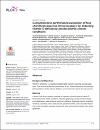Comprehensive performance evaluation of four chemiluminescence immunoassays for detecting vitamin D deficiency across diverse clinical conditions
| Author | AlHamad, Tasneem |
| Author | Younes, Salma |
| Author | Chaar, Dayana El |
| Author | Nizamuddin, Parveen B. |
| Author | Mohannadi, Eiman Al |
| Author | Alghanim, Asmaa |
| Author | Younes, Nadin |
| Author | Al-Dewik, Nader |
| Author | Laiwattanapaisal, Wanida |
| Author | Ammaranond, Palanee |
| Author | Hawken, Phillip |
| Author | Abu-Raddad, Laith J. |
| Author | Nasrallah, Gheyath K. |
| Available date | 2025-09-03T11:36:35Z |
| Publication Date | 2025-08 |
| Publication Name | Plos One |
| Identifier | http://dx.doi.org/10.1371/journal.pone.0329796 |
| Citation | AlHamad, T., Younes, S., El Chaar, D., Nizamuddin, P. B., Al Mohannadi, E., Alghanim, A., ... & Nasrallah, G. K. (2025). Comprehensive performance evaluation of four chemiluminescence immunoassays for detecting vitamin D deficiency across diverse clinical conditions. PLoS One, 20(8), e0329796. |
| ISSN | 1932-6203 |
| Abstract | Background/Objectives Vitamin D deficiency is a significant global health concern, requiring accurate diagnosis. This study evaluates the performance of four chemiluminescent immunoassay (CLIA) platforms; Snibe, Roche, DiaSorin, and Architect for vitamin D measurement. Methods A total of 345 serum samples, selected to represent a broad range of vitamin D levels and diverse health conditions, including pregnancy, chronic kidney disease, and osteoporosis, were analyzed using four platforms. Diagnostic metrics, including sensitivity, specificity, and overall percent agreement (OPA), were calculated. Spearman’s rank correlation and bias assessment were performed to evaluate inter-assay agreement. Results Spearman’s rank correlations were strong to very strong across the platforms, ranging from r = 0.924 to r = 0.969, reflecting high inter-assay concordance. Pairwise comparisons indicated that Snibe demonstrated high specificity (98–99%) and strong agreement with DiaSorin (κ = 0.91), while DiaSorin maintained a favorable balance between sensitivity (86–98%) and specificity (94–99%). Roche showed consistent diagnostic characteristics, with sensitivity ranging from 93–99% and specificity from 85–96%. Architect exhibited high sensitivity (97–99%) but relatively lower specificity (81–92%). Conclusions All platforms demonstrated robust diagnostic performance. Snibe showed notably high specificity, while DiaSorin offered balanced sensitivity and specificity. These findings underscore the relative strengths of each platform and support their use in clinical evaluation of vitamin D status. |
| Language | en |
| Publisher | The Public Library of Science (PLOS) |
| Subject | chemiluminescent immunoassay vitamin D |
| Type | Article |
| Issue Number | 8 August |
| Volume Number | 20 |
| ESSN | 1932-6203 |
Files in this item
This item appears in the following Collection(s)
-
Biomedical Sciences [843 items ]


